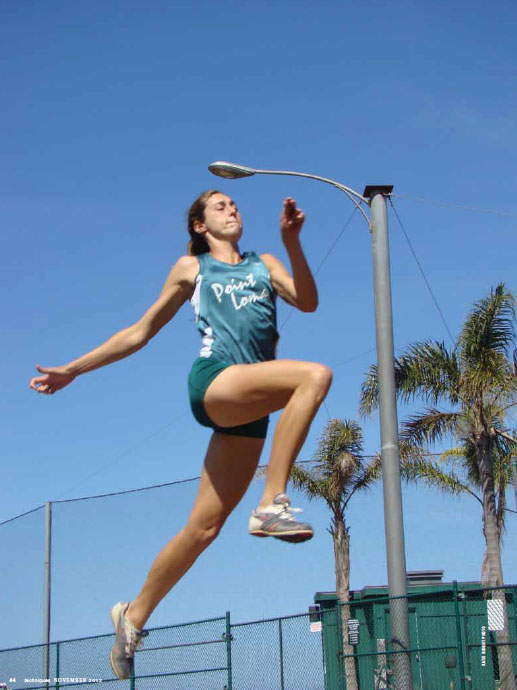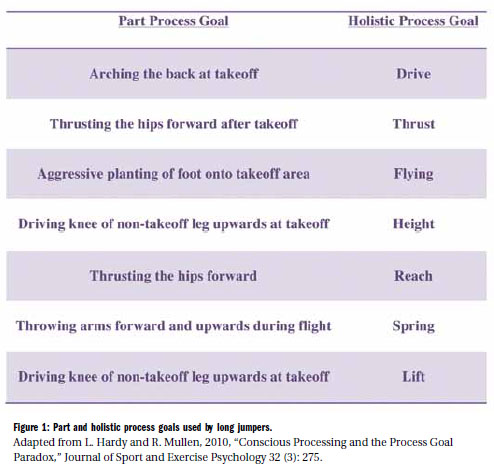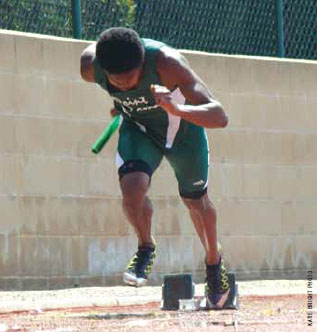| Trusting The Process
Implementing process goals for inexperienced and struggling athletes Originally Published in Techniques Magazine, Provided by: USTFCCCA
 In psychology, goals act as regulators of human action, and challenging, specific goals will lead to better performance than "achieve your best" or "no goal" situations. So, it is easy to see why, among coaching circles, goal setting programs are incorporated to help athletes achieve success. But setting the right types of goals for individuals can be a challenge, as incomplete goal setting can have a negative effect on an athlete's performance. Coaches who deal with novice and struggling athletes can find themselves in a difficult position when wanting to help athletes set goals. How do you set goals for someone who has never competed? What type of goals do you set for someone who has not experienced personal success on the track? What kind of goals can be set for athletes who are having a disappointing season or are dealing with low self-esteem? These are important and good questions to ask, and some of the answers may lie in implementing process goals. BACKGROUND Outcome goals are necessary as an athlete becomes more experienced, but at the early stages of learning a sport, process goals can be highlighted to bring the athlete some early success. They can also help the struggling athlete, who may be dealing with low self-esteem and internal or external pressures to perform better. Using process goals can help athletes avoid the negative aspects of outcome goals, which include higher stress levels and a lack of focus. Using process goals can lead to improved concentration, lowered anxiety and increased self-confidence that may even be exaggerated in a novice or struggling athlete. IMPROVED CONCENTRATION By focusing on discrete behaviors, athletes can concentrate on important techniques for their sport. For example, a novice runner would find it more beneficial to focus on the position of their hands than worrying about their finish time. By focusing on times or places, young or struggling athletes may actually be distracting themselves from what they need to concentrate on in order to succeed. Using process goals, however, to improve concentration goes beyond daily training sessions. It actually helps the athlete improve skills and techniques by allowing them to concentrate on discrete behaviors (processes) that combine to constitute a complete complex action. This is in contrast to focusing on outcome goals, which can distract the athlete, as they tend to worry about competition outcomes and not task-relevant strategies. For complex tasks, long-term seasonal training programs can allow sufficient time for goals to improve development of skill-enhancement strategies that are key to boosting performance (Kingston & Hardy, 1997). Processes provide athletes with limited focuses, which if followed, will increase the likelihood of improving the target behavior or outcome goal. For example, a young long jumper might set a goal to improve his flight time during the course of the season. In order to complete this long-term complex task, the athlete would benefit from concentrating on a process goal, such as aggressive planting of the foot onto the takeoff area. A study conducted by Hardy, Jones and Gould (1996) supports this, as they found process goals could logically form part of the technique development that lead to the eventual automation of the performance. So for young athletes who have yet to develop strong technical abilities, process goals can encourage positive concentration habits to improve their marks. Coaches who structure goal setting programs or work with athletes to create them cannot underestimate the potential influence goals can have on athletes. Outcome goals can elicit negative effects in the form of anxiety. The nature of outcome goals is not inherently bad, but the overemphasis of them (especially related to competition) can create anxiety and hurt performance as the athlete spends undue time worrying about the goals instead of accomplishing a task (Weinberg & Gould, 2011). The proper implementation of process goals may provide coaches a remedy for the shortcomings we see in outcome goals. Kingston and Hardy (1997) demonstrated that process goal setting training groups demonstrated improvements in psychological processes thought to support effective performance, such as anxiety control. By focusing on form and technique as goals, athletes are required to allocate substantial attentional resources to that objective. This focus results in a reduction in attentional resources available for otherwise superfluous information, especially in competitive situations. In theory, focusing on skills will take away from potentially anxiety-inducing thoughts, such as trying to win a race for the first time or qualifying for an elite meet. For athletes new to the sport, it can be intimidating competing in their first track or cross country meet, especially if the thought of getting last or lapped is in the back of their minds. And while for some beginners getting last may be a reasonable outcome, telling the athlete that will lead them to negative thinking, and potentially bad habits. Using a process goal will give the athlete a task to focus on rather than worrying about the perceived outcome. Using a cue, such as "stay tall" will help the athlete gain control of the situation. Process goals will also help new athletes manage their anxiety. When they become nervous about a race, the athlete can think, or be reminded, about what steps they need to take in order to perform well, which can lead to lower anxiety levels. INCREASED SELF-CONFIDENCE Further examinations of process goals show us that their use can have a positive effect on self-confidence. Process goals allow performers to exert greater control over the performance result than outcome goals do. This increased control of goal achievement has a positive effect on self-confidence. Kingston and Hardy (1997) stated that the increased self-confidence athletes show with process goals also represents an increased understanding of how to attain other types of goals. For example, a runner accomplishing the goal of staying relaxed in the middle of a race will experience increased self-confidence and begin to understand what actions are required in order to run faster. Further examinations of process goals show us that their use can have a positive effect on self-confidence. Process goals allow performers to exert greater control over the performance result than outcome goals do. This increased control of goal achievement has a positive effect on self-confidence. Kingston and Hardy (1997) stated that the increased self-confidence athletes show with process goals also represents an increased understanding of how to attain other types of goals. For example, a runner accomplishing the goal of staying relaxed in the middle of a race will experience increased self-confidence and begin to understand what actions are required in order to run faster. Process goals are also beneficial in this area as athletes may lose an event, but will not lose self-confidence if process goals are achieved. For example, a runner may not have set a personal record, but they were able to achieve their process goal of speeding up at the end of the race. This positive goal achievement increases self-confidence and could result in both increased skill and better performances later on. For more experienced athletes who have developed higher levels of technical ability, coaches may want to apply process goals more carefully as they could possibly lead to negative outcomes. By focusing on aspects of a performance, athletes can set process goals that help them stay focused and improve their performance. But much like outcome goals, the improper use of process goals can lead to higher state anxiety, especially in already anxious athletes. This is because process goals can lead to conscious processing. Conscious processing as defined by Masters (1992) is the idea that skilled athletes may show performance impairment due to the disruption of automatic task control. This happens when athletes attempt to ensure task success by adopting conscious control that is usually associated with inexperienced athletes. For example, an experienced athlete might be struggling with the second phase of the triple jump during competition. But if the athlete were to make it a process goal to improve on one aspect of the second phase during competition, it may not be beneficial. This is because the athlete is over-focusing on one aspect of a complex action, which could result in a series of movements that will impair fluidity and efficiency and could hurt performance.  A study conducted by Jackson, Ashford and Norsworthy (2006) examined whether process goals impaired performance under pressure in a soccer-dribbling task. The results showed that using a part process goal had a negative effect on dribbling performance regardless of the level of pressure. Coaches can combat this negative result by separating process goals into two different categories: part process goals and holistic goals. Mullen and Hardy (2000) have suggested part process goals lead to inferior performance, while holistic goals maintain or improve motor performance. This is because holistic goals allow the athlete to incorporate several tasks into a single global movement and avoid conscious processing. Mullen and Hardy have also suggested that if process goals are a part of a pre-competition routine, they should be holistic in nature in order to avoid increased levels of cognitive state anxiety. A runner who wants to avoid clenching his fists during a race would benefit from making it his goal to stay "smooth" instead of listing an of the part process goals before his race. Using a cue, such as "smooth" will trigger the behavior of holding the hand loosely while running to avoid tightening up. This cue will help the athlete from over-thinking and will allow for the automation of the appropriate motor actions. Holistically approached process goals ultimately allow the appropriate sub-actions of a movement to be generated more automatically, an action known as "chunking." This is in direct contrast to part process goals that lead athletes to focus on parts of the movement using knowledge they have built up over years of experience. Athletes want to "chunk" this knowledge together, instead of separating it into parts that lead to over-thinking, anxiety and slower movements. Usually, coaches will not have issues with conscious processing with novice athletes, but holistic process goals should be used with experienced athletes that may be struggling to perform over the course of a season. When introducing process goals to inexperienced or struggling athletes, the initial intent may not be for them to perform better, but to set them up for success, which will hopefully keep them engaged in the sport. Process goals may not turn around a struggling athlete's season or turn a new runner into a star runner, but they may give the athlete the boost of confidence they need to stay motivated for following seasons. This is not to discredit outcome goals, as researchers have proved that the most beneficial goal setting programs use both types. Outcome goals are very useful for taking athletes to the next level (however that may be defined), as athletes choose to become more competitive. Process goals are an introduction to the world of healthy goal setting programs, and if done right, they can lead to an athlete's improvement each season. The key is to prioritize the goals in different contexts and continually emphasize process goals alongside outcome goals. For every outcome goal a team or athlete sets, several process goals should be set to achieve the outcome. Unfortunately, coaches in every sport often put too strong an emphasis on outcome goals. Although these types of goals can provide motivation to get better, for many inexperienced athletes they are only good for pointing out shortcomings. In order to keep athletes motivated and excited to compete, process goals are essential. It would be beneficial for every difficult practice and competition to have at least one process goal that the coach and athlete can discuss, regardless of the performance for that day. Process goals can aid coaches in teaching positive habits, thoughts and behaviors. As Filby, Maynard and Graydon stated, "The benefits of adopting an outcome goal are realized only when the outcome goal is combined with the prioritization of a process orientation immediately before, and during performance" (p. 242). Here are some suggested process goal behaviors and cues that can be used for runners:
The possibilities are endless. Whatever technical, mental or physical aspect the athlete needs to work on can be transformed into a process goal. Keep in mind that there are two basic parts of goal setting: designating and evaluating. This means process goals need to be defined and discussed in order to be beneficial. REFERENCES Filby, W.C.D., Maynard, LW., & Graydon, J.K (1999). The effect of multiple-goal strategies on performance outcome in training and competition. Journal of Applied Sport Psychology, 11, 230- 246 Hardy, L. Jones, J.G., & Gould, D. (1996). Understanding psy-chological preparation for sport: Theory and practice of elite performers. Chichester, UK: John Wiley. Jackson, R.C., Ashford, KJ., & Norsworthy, G. (2006). Attentional focus, dispositional reinvestment, and skilled motor performance under pressure. Journal of Sport & Exercise Psychology, 28, 49-68. Kingston, K, & Hardy, L. (1994). Factors affecting the salience of outcome, performance, and process goals in golf In. A Cohran & M Farrally (Eds.), Science and golf 2 (pp.144-149). London: Chapman-Hill Kingston, KM., & Hardy, L. (1997). Effects of Different Types of Goals on Processes That Support Performance. The Sport Psychologist, 11,277-293. Masters, R.S.W. (1992). Knowledge, knerves and know-how: The role of explicit versus implicit knowledge in the breakdown of a complex motor skill under pressure. The British Journal of Psychology, 83,343-358. Mullen, R., & Hardy, L. (2000) State anxiety and motor performance: Testing the conscious processing hypothesis. Journal of Sports Sciences, 18, 785-799. Mullen, R., & Hardy, L. (2010) Conscious Processing and the Process Goal Paradox. Journal of Sport & Exercise Psychology, 32(3), 275. Weinberg, R.S., & Gould, D. (2011). Foundations of Sport and Exercise Psychology. (5th ed.). Champaign, IL: Human Kinetics Landon Bright received his B.A. in Journalism from Point Loma Nazarene University in San Diego, California, where he ran cross country and track. He currently serves as the cross country and track & field graduate assistant at Hardin-Simmons University in Abilene, Texas, where he is pursuing his master's degree in Kinesiology, Sport and Recreation. |








